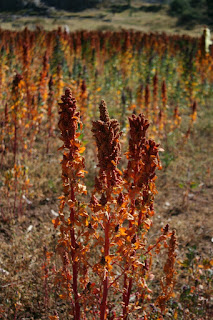There are many variations on the spelling of the old Inca capital, being hispanicised from the Quechau name, Qosco. However you choose to spell it, we are here, looking at the magnificent UNESCO heritage city from atop a hill in Tambillo.
We started today with a drink we prepared from a bag of Soykima - an acronym of the powdered soya and Andean grain
kiwicha (amaranth) and
maca root. With a banana and a cup of Peruvian coffee, it felt like the healthiest thing we had put into our bodies after the nutritionally dubious food of Bolivia.
 |
| Inca trail |
Our walk into town takes us down the hill using a direct Inca trail, past fields of red and black quinoa.
 |
| Temple of the Moon and a field of quinoa |
 |
| Black quinoa |
 |
| Red quinoa growing |
The route follows the cobbled streets of San Blas, the artisan area, which is replete with alleyways and courtyards brimming with handicrafts, from textiles to ceramic bulls (for good luck), to beautiful tableaux of daily life created from a paste containing potato, corn and wheat that dries incredibly hard.
 |
| San Blas streets |
Of course these stalls and the larger
feria are aimed at the tourist souvenir market. The streets are lined with women dressed in typical Peruvian costume holding baby lambs (often also wearing a knitted hat) in their arms for petting. As we continued towards the main square, Plaza de Armas, whose white colonial buildings stand on the foundations of Inca masonry, the cute lambs give way to women offering massages at every ten paces.
The central square is a strange mix of Inca, Spanish colonial architecture, and North American brands, McDonalds, Starbucks, and KFC. There is, naturally, even an Irish pub on one corner.
 |
| Plaza de Armas |
A multicoloured rainbow flag flies prominently in many locations, from bars and shops and even on the roof of La Catedral del Cuzco, right next to the cross.
 |
| Love everyone |
Given all the recent news about gay pride and the landmark ruling that gay marriage has been made legal in all states of the USA, I initially took this to be a message of solidarity from Peru and the Church. However, this is a misconception that many visitors make, as the flag is in fact the official flag of Cuzco and apparently represents
Tawantin Suyu, or Inca territory.
 |
| Fire in the square |
Food in Peru, we discovered before arriving, is a big deal. Our Spanish teacher in Santiago declared Peruvian food "the most delicious" of all Latin America. Internet research revealed a number of excellent restaurants in Cusco, many of which are vegetarian. We picked one of the more interesting ones and went for lunch.
 |
| Shaman. Vegan. Raw |
Our healthy eating kick continued at a Shamanic "vegan and raw" restaurant, where we enjoyed three courses for 9.90 soles. This included a delicious salad a soup packed full of vegetables and a main of rice and quinoa with pumpkin stew and a vegan cauliflower cheese. A glass of
chicha morada - a non-alcoholic drink made from purple corn - did a very good impression of looking like red wine.
 |
| Colourful salad |
 |
| Healthy soup |
 |
| Quinoa and chicha morada |
In the afternoon, we took a walk along the picturesque streets of Cusco town centre, through Plaza de San Francisco and to the main market at Mercado San Pedro. Part of the market was given over to fresh produce, meat and cheese, while at the back, lines of cheap eateries plied customers with bowls of hot food.
 |
| Queso! |
 |
| Pff... idiot |
The front of the market was dedicated to arts and crafts, some of which we had seen at San Blas, while others were quite disturbing indeed.
 |
| O....K...? |
Given the time difference (one hour behind Bolivia), it gets dark around 6pm. As dusk fell and the already waning moon made an appearance, we made our way to La Esencia for a performance of art and drama. La Esencia is a cosy upstairs place which serves exclusively hot drinks perfect for the chilly evenings, such as mate (infusions) made from local herbs
hierba buena,
toronjil, and
muña, among others.
The drinks complement the performances, which tonight were a double bill. The first,
Voces Ancestrales, was a storyteller from Chile, whose folk tales of precolonial times centred around love and respect for the earth and environment, which had been forgotten by the people that lived there, with dire consequences. Complete with puppets, the performance was suitable for children but attended by only one vocal young boy. Fortunately, the simple language and clear enunciation meant that we could understand a good deal of what was going on.
The same could not be said of the next display,
Un Deseo, which involved an Argentinian lady dressed in a silver chef's hat, talking a nonsense language as she pretended to be an alien landing in Earth's desert. Despite the lack of a language barrier, this confounded me more than the previous round of stories.















No comments:
Post a Comment